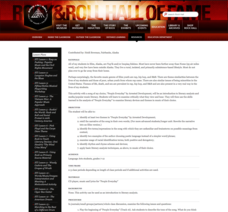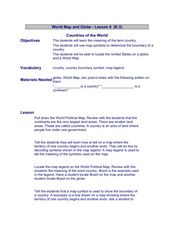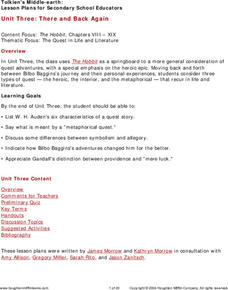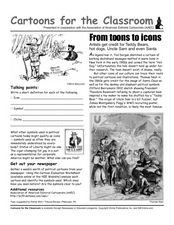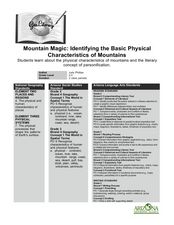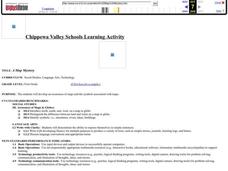Curated OER
Creating Civic Awareness Through Artistic and Literary Forms
Interpret current events using editorial cartoons and other print media. Middle schoolers explore the meanings of literary and artistic terms such as satire, irony, and caricature. They visit internet sites to develop an understanding of...
Curated OER
Cartoons for the Classroom: 2012 Mid-Term Elections
Use a political cartoon to help scholars grasp the significant turnover in Congress following the 2012 mid-term election. A Mike Keefe cartoon uses symbols and current political lingo to convey perspective on the issue, and background...
Owl Teacher
Introduction to World of Geography Test
Assess your learners on the five themes of geography and the most important key terms and concepts from an introductory geography unit. Here you'll find an assessment with 15 fill-in-the-blank and 14 multiple-choice questions, sections...
National Endowment for the Arts
Teacher's Guide: The Great Gatsby by F. Scott Fitzgerald
A 10-lesson unit takes high schoolers through a novel study of F. Scott Fitzgerald's The Great Gatsby. To start, students learn about Fitzgerald's background and gain historical context that prepares them for a reading of the book. The...
Curated OER
Lesson: Emphasis on Exaggeration
His ears, head, and designs are all an exaggerated form of art. Learners examine a South American sculpture in terms of how exaggeration was used to convey meaning. They then work through the design process as they create similarly...
Curated OER
The Rock and Roll Hall of Fame
"People Everyday" offers class members an opportunity to develop their literacy analysis skills and to develop media literacy. Guided by an included list of discussion questions, groups examaine the word choice, literary devices used,...
ReadWriteThink
Analyzing Famous Speeches as Arguments
A speaker, a message, an audience. After analyzing these elements in Queen Elizabeth's speech to the troops at Tilbury, groups analyze how other speakers use an awareness of events, and their audience to craft their arguments....
Curated OER
History Personified
Students explore historical events by writing a research paper using personification.
Curated OER
Sarcasm
Learners often regard sarcasm as a "you know it when you see it" language phenomenon, leading to confusing tone and humor in student writing. This presentation not only defines sarcasm (and irony) in plain terms, it also provides many...
Curated OER
Islam Card Matching Game
In this Islam matching card game, students recognize the different words and symbols associated with the Islamic religion. They learn different religious terms and images by mixing the Islamic cards up with other religion cards.
Curated OER
We the Past
Students study philanthropy related terms and philanthropy in the United States and their local community. In this philanthropy lesson plan, students study pictures of present and past Americans and discuss their philanthropic acts....
Museum of Tolerance
Immigration Journeys
Through the journey of four stories of immigration, scholars complete graphic organizers and apply knowledge to create a visual representation of their findings on a large poster. Third and fourth readers write a letter to their...
Curated OER
Countries of the World
Students define the meaning of the word country. In this countries of the world map lesson, students identify boundaries, countries, and symbols within countries on the map. Students distinguish the words country and continent.
Curated OER
Literature: Isabel Allende
Students watch and respond to a Bill Moyers Now video on the Chilean author, Isabel Allende. They brainstorm a list of recent events that might inspire writers and choose one to write about in poetic, diary, or short story form.
Curated OER
My Favorite Holiday
Students create a My Favorite Holiday Calendar Page. They recall the months of the year and identify the various components of a calendar. Students also apply their learning about holiday customs to consider their own favorite holiday...
Curated OER
The Hobbit
Students list W.H Auden's six characteristics of a quest story. They say what is meant by a "metaphorical quest." Pupils discuss some differences between symbolism and allegory. Students indicate how Bilbo Baggins's adventures changed...
Curated OER
Vetern's Day, A Chance to Honor Those Who Served Our Country
Students examine some of the symbols, songs, and pledges that represent our country as well as the liberties they enjoy today due to those who served. They discuss the rules for displaying the United States Flag, practice folding the...
Curated OER
Cartoons for the Classroom: Explaining Social Security with a Metaphor
In this current events worksheet, students analyze a political cartoon about Social Security. Students then respond to 4 short answer questions.
Curated OER
Cartoons for the Classroom: From Toons to Icons
In this current events worksheet, students analyze political cartoons that feature icons like the hot dog and the teddy bear. Students respond to 3 talking point questions.
Curated OER
Mountain Magic: Identifying the Basic Physical Characteristics of Mountains
Students read about and identify on maps the physical characteristics of mountains. For this mountains lesson plan, students also write about the characteristics using personification.
Curated OER
A Map Mystery
First graders solve a mystery by following map clues. In this map clues lesson plan, 1st graders follow a computer program called Neighborhood Map Machine. In this program, it gives students directional and spatial clues in order to...
Curated OER
Who Has the Power?
Students explore the concept of federalism and the purpose of government. How government powers are acquired, used, justified, and the rights and responsibilities of citizens are investigated in this lesson.
Curated OER
The Flag
Students see the flag as a symbol. In this flag lesson, students look at the flag to see different patterns and shapes. They review the importance of the flag and its meaning to the United States.
Curated OER
Social Studies: What Is Folklife?
Students read an essay about folklife and record their thoughts in journals. After discussing the terms associated with the topic, they complete worksheets on types of folklife, pop, elite, and folk cultures. Depending on the age group,...





